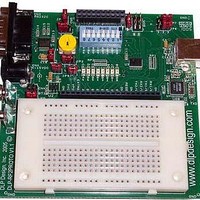DLP-RF2-PROTO DLP Design Inc, DLP-RF2-PROTO Datasheet

DLP-RF2-PROTO
Specifications of DLP-RF2-PROTO
Related parts for DLP-RF2-PROTO
DLP-RF2-PROTO Summary of contents
Page 1
... DB9 male connector are provided for connection to a legacy RS232C device. Standard serial RX and TX signals (0 & 3 volt) are provided for communicating with the DLP-RF2 transceiver. Selected baud rates (2400, 4800, 9600 (default), 14400, 19200, 38400, 128000, 250000 baud) can be used to communicate with the RF2 via either the USB or DB9 interfaces ...
Page 2
... The baud rate is set by the host application at run time. Operational power for the DLP-RF2PROTO and DLP-RF2 can be taken from the host PC via the USB interface. All that is required is a user-supplied, 6-foot USB cable and to set the power select jumper (JP5) correctly ...
Page 3
... LOW POWER MODE JUMPER Jumper JP6 can be used to hold port pin RX2/C1 low at power up of the DLP-RF2. If using the SIPP firmware in the DLP-RF2 as shipped from DLP Design, on power up the RF2 will immediately enter the low-power mode drawing less than 40 microamps of current at pin 12 of interface connector CN5. The RF2 module will wake up periodically from the low-power mode and attempt to check in with the system controller ...
Page 4
... A/D inputs. The potentiometer can be driven by either the 3-volt power supply or the external voltage reference. For additional details on the use of the A/D converter please refer to the datasheets for the DLP-RF2 and the MC9S08GT60 microcontroller. ...
Page 5
GND 29 AGND 9 GND 17 GND TX1/E0 19 BKGD 1 2 3VCC 3 VPOT 4 EXTREF ...

















